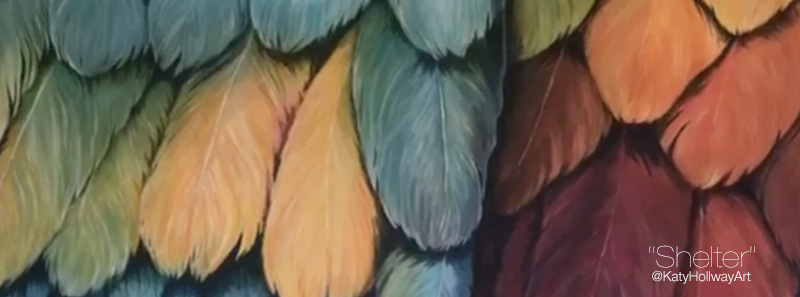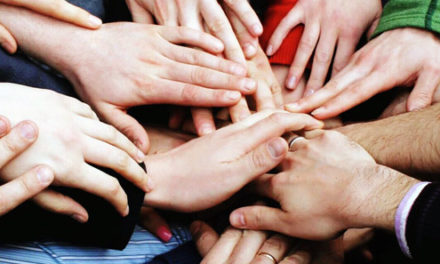MISSIONS IN A COVID CRISIS: CREATIVITY IMPLICATIONS
[12 Minute Read]
Dear fellow participants in God’s mission,
Grace and peace to you in the name of the Lord Jesus Christ.
How many times in the last two months have you been surprised or profoundly moved at the creative responses to the COVID-19 crisis visible on social media? Responses such as the “UK Blessing” (close to 3 million views), the painting of “Shelter” (see image above) to grieve a loss due to coronavirus, or the balcony worship of a community in Israel (see video below) have touched us deeply and helped us to feel connected to one another.
The global pandemic has affected all of our lives worldwide in a way no one could have imagined just a few months ago. Zoom and similar platforms have become the “new normal” for so many different areas: schooling (from elementary through university and seminary), business of all sorts, church services and other meetings, etc. And this “not business as usual” paradigm has certainly of necessity taken root in the world of the arts, including artistic missions activities, as well. Here, as in so many other fields, this “new normal” will have lasting effects even when the crisis has passed; new approaches borne of necessity will find a place in our ongoing ministries.
We are experiencing an expanded appreciation of the vast amount of rich artistic performances and expressions available online.
Challenges & Decisions
The required social distancing during this time of pandemic has removed the possibility of face-to-face collaborative arts-related gatherings and events, as well as group performance art of many kinds. For example, the sixth Global Consultation on Music and Missions had been scheduled for July 2020, but had to be postponed until 2021 because of the safety and travel challenges for this international event.
On the other hand, the Ethnodoxology course slated to run as an intensive for Dallas International University (DIU) the first week of May went on as scheduled—but on the Zoom platform, as students stayed in place (more on that below).
Opportunities
Many have expressed during this season of distancing with its streaming services, Zoomed Bible studies and online Sunday class meetings, that they have been reminded afresh that the church is the people, not the building. A valuable corrective in any age! One blessing found by sheltered artists has been additional time and focus (and fewer distractions) for individual artistic and creative endeavors: music making and composing, visual art projects, poetry, drama, dance, and more.
We are experiencing an expanded appreciation of the vast amount of rich artistic performances and expressions available online through YouTube and other sites, as well as the possibility afforded by these platforms for sharing new artistic contributions. Online cooperative choral efforts such as the aforementioned “U.K. Blessing” have increased in popularity by providing ways for connecting and collaborating in music endeavors in spite of social and geographical distance.
Online music creations aren’t the only kinds of fruitful collaboration for missional goals. A recent article Creating Local Arts Together 2.0 by Anya Ezhevskaya and Juan Arvelo, published in the Global Forum on Arts and Christian Faith (Vol. 8), discusses a model for facilitating creativity for online communities. Their case study applied an arts facilitation model to an online community of ethnodoxologists, successfully demonstrating that artists do not have to be physically present in the same place to create together, but they can instead gather in online communities to craft pieces of art that meet their needs and provide a better future” (2020, 1).
Educational institutions have also flexed to meet the challenge. A course on “Biblical Worship” that I was scheduled to teach for the Doctor of Ministry program at Singapore Bible College in early May had to be moved online. The school (which, as most schools, had during this time moved all its teaching online) had learned by recent experience that the originally planned eight-hour class days would not be educationally effective in the Zoom context.
Therefore the decision was made to limit the class days to four hours each; for the other class hours, materials were posted online each day (on the school’s Moodle platform) to reinforce what had been learned in class that day and also to prepare the students for the next day’s themes. This afforded the opportunity to provide the students with a wide array of media for individually paced study and reflection: videos (including film clips; videos of important messages; and digests of global worship conferences demonstrating a wide diversity of worship expressions: different languages, musical styles, instruments, dance, drama, and visual arts); audio presentations and messages; and additional reading and interactive assignments.
These materials greatly enriched the student experience. Discussions during the class sessions themselves were not really hampered by the online medium, and participatory exercises such as training in expressive reading of Scripture proceeded without difficulty. In addition, the breakout room option in Zoom lent a change of pace and expanded opportunities for student-to-student interaction.
Robin Harris, Director of the Center for Excellence in World Arts at DIU, course head for DIU’s “Introduction to Ethnodoxology” course (and co-leader with Jill Ford of the WEA Mission Commission’s Arts in Missions/Creativity Current), reported that the Zoom version of the course exceeded her expectations. The class represented nine different countries of origin, as well as many other places of present or future service. The online format required some retooling, but there were upsides as well:
- The devotionals starting each class day, billed as “Arts with God,” gave the students opportunity to respond to the Scriptures in various artistic ways (song, visual expression, movement, or poetry), which could then be discussed and shared with the class.
- The online format was ideal for presenting Powerpoints: eliminated were all usual concerns about cables and connections, projector resolutions, clarity of images, room illumination or inexact color reproduction. And image and video sharing of artistic examples were likewise seamless. The professors were encouraged to help prevent “Zoom fatigue” by regularly interspersing discussions and audiovisual materials during their lectures.
- Student feedback in the group setting worked fine (as long as Internet connections cooperated!), and additional Zoom features enhanced participation opportunities: the chat box allowed for instant responses, reactions and questions; and breakout room allowed for smaller groups to interact and share.
The course regularly climaxes with a chapel service on the last day, planned and presented by the entire class and characterized by a wide diversity of cultural and artistic expressions, as championed in the course itself. The chapel in the past was presented live for the DIU community, but this time took place online (see the video here). That allowed 35 countries to be represented at the online event. A great variety of artistic expressions (from North America, Ireland, West Africa, Mongolia, and Indonesia) were offered up, focusing on Psalm 86:9, which reads “All the nations you have made will come and worship before you, Lord; they will bring glory to your name” (NIV).
The service featured visual arts, musical and Scripture presentations in multiple languages, chat-box confession and prayers of lament for what divides us, and several offerings by all participants on the screen in Gallery view. For example, the “nations of the world bringing their glory” were represented by a display of multicultural “outfits and artifacts,” a “fabric mosaic” made up of different pieces of brightly colored fabric held up to participants’ cameras, and a concluding song—“Is He Worthy?”—with all participating in American Sign Language (see here).
…the present reality is confronting us with the possibility of a “new normal,” where technology can enhance many of our efforts in training, creating, and networking for the purpose of mission.
Future Implications
God never wastes our experiences. Lessons learned during this unexpected and undesired time of sheltering have opened up new possibilities for how we do arts-related missions in the future.
- Even in the business world, the realization is growing that, in spite of the obvious preference for face-to-face contact with customer and clients, online connecting allows for more frequent contact with those same people. Similarly, networking among creative and artistic persons can be greatly expanded through online platforms, and artistic products and presentations can be shared in this way as well. Newfound skills in adapting creative works for online sharing will open up new potential for wider dissemination of those works.
- In particular, one can anticipate the continuation and even expansion of choral and vocal mosaic productions.
- The Global Consultation on Music and Missions is considering offering in the future, along with its international gatherings, online seminars and presentations which have the obvious potential for reaching a far greater number of people worldwide (and at far less cost).
- The “Introduction to Ethnodoxology” course success (including the richly diverse chapel service) has opened up the potential for it to be offered to students all over the world without them having to travel to a central location.
- Adding streaming access promises to change the future, and expand the outreach, of many different types of training and artistic events. The need and the preference for face-to-face contact will always be there, of course; but the present reality is confronting us with the possibility of a “new normal,” where technology can enhance many of our efforts in training, creating, and networking for the purpose of mission.
God works in mysterious ways, His wonders to perform!
God works in mysterious ways, His wonders to perform!
He plants his footsteps in the sea, and rides upon the storm.
Deep in unfathomable mines of never failing skill;
He treasures up his bright designs, and works His sovereign will.
Ye fearful saints fresh courage take, the clouds ye so much dread
Are big with mercy, and shall break, in blessings on your head.
Judge not the Lord by feeble sense, but trust him for his grace;
Behind a frowning providence, He hides a smiling face.
His purposes will ripen fast, unfolding ev’ry hour;
The bud may have a bitter taste, but sweet will be the flow’r
Blind unbelief is sure to err, and scan his work in vain;
God is his own interpreter, and He will make it plain.
William Cowper (1774)
Pray
- For a fresh release of creative expression in witness and worship throughout the world that declares the hope we have in Christ and demonstrates the gifts that God has given us to glorify His name.
- For creativity to emerge out of chaos to help lead us forward in transforming our communities and wider societies for the better, revealing the heart of God for all people.
- That leaders will arise to help us imagine new ways of being, in both our pandemic and post-pandemic realities—one which emphasizes equality and embraces diversity in ways that point to God’s now/not-yet Kingdom shalom.
- That people who do not know Christ, and who persecute those who do, will have their hearts and minds opened to the love of God in-Christ through the beauty and power of creative artistic expressions—visual, musical, physical, virtual, in multiple media forms.







